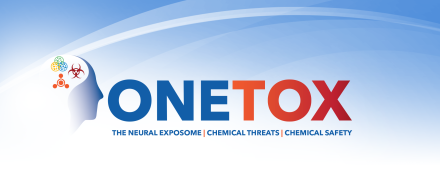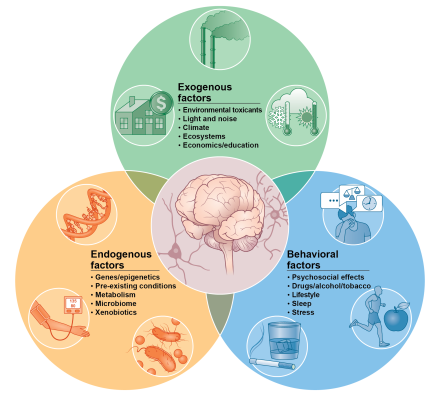
ONETOX | Neural Exposome and Toxicology Programs
It is widely acknowledged that most diseases and disorders cannot be attributed to genetic factors alone. Coined by Chris Paul Wild in 2005 (Wild, C.P. 2005 Cancer Epidemiol Biomarkers Prev. 14(8):1847-50), the term “exposome” describes the totality of internal and external exposures across the lifespan that affect human health. The “Neural Exposome” are those exposures that have an impact on neurological disease and disorders, and overall nervous system health. The exposures described in the exposome not only include environmental chemical and biological toxins, but also psychosocial factors and internal factors such as diet and the microbiome, and these exposures may occur anytime from in utero to late in life. A better understanding of how these exposomic factors interact with genes will lead to identifying more precise and effective intervention strategies, especially because many of the exposures are potentially modifiable.

The overall goal of ONETOX is to enhance basic, translational, and clinical NIH research on the effect of the neural exposome on nervous system diseases and disorders by fostering more collaborative research within the neuroscience research community. ONETOX provides information and tools to help break down barriers to research between different scientific disciplines which can be used to establish productive team science for targeted funding opportunities. Because of the large number and different kinds of exposures within the Neural Exposome that occur across the lifespan, ONETOX collaborates with many different Institutes and Centers across the NIH to obtain a full understanding of how these exposomic factors affect brain and nervous system health.
Tamiz AP, Koroshetz WJ, Dhruv NT, Jett DA (2022)
A focus on the neural exposome.
Neuron, 110:1286-1289. PubMed ID: 35349785
Resources and Tools
Contacts
David A. Jett, Ph.D. | Director, ONETOX
jettd@ninds.nih.gov
Neel Dhruv, Ph.D. | Health Program Specialist
neel.dhruv@nih.gov
Amir Tamiz, Ph.D. | Director, Division of Translational Research
amir.tamiz@nih.gov
Funding Opportunities
Neural Exposome Funding Opportunities
Neural Exposome Notices and Other Funding Announcements
News & Events
Tamiz AP, Koroshetz WJ, Dhruv NT, Jett DA. 2022. A focus on the neural exposome. Neuron. PMID: 35349785.
Neuroscience 2022: The Neural Exposome and Why it's Important to You! | November 15, 2022; 6:30 pm PST
Related Topics
Databases:
Comparative Toxicogenomic Database (CTD)
The Comparative Toxicogenomic Database (CTD) launched in 2004 is a well-known publicly available resource for curated data on the linkage between human exposures and how they influence genes, biology, and human health.NeurotoxKB
NeurotoxKB provides information on potential neurotoxicants that is compiled and manually curated along with supporting evidence from published scientific studies.Environmental Neuroscience Reports:
The National Academies of Sciences Engineering Medicine Environmental Neuroscience: Advancing the Understanding of How Chemical Exposures Impact Brain Health and Disease: Proceedings of a WorkshopIntegrating the Science of Aging and Environmental Health Research: Proceedings of a Workshop
